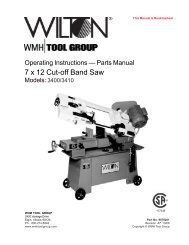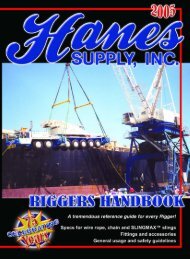Continental L-Head Overhaul Manual - Igor Chudov
Continental L-Head Overhaul Manual - Igor Chudov
Continental L-Head Overhaul Manual - Igor Chudov
Create successful ePaper yourself
Turn your PDF publications into a flip-book with our unique Google optimized e-Paper software.
Figure 145 -- Checking Bearing Clearance with<br />
Feeler Stock<br />
An alternative method is to use a piece of<br />
feeler stock (the thickness of which should be<br />
equivalent to ~:he maximum clearance permissible<br />
in the bearing) lengthwise, in the bearing shell, on<br />
a film of oil. Assemble the bearing cap and tighten<br />
the screws, torquing them to the specifications, -then<br />
try to turn the crankshaft by hand to determine<br />
whetller or not you can feel a drag.<br />
If a definite drag is felt and the piece of feeler<br />
stock is equivalent to, but no more in thickness<br />
than the maximum clearance specified, you may be<br />
sure that neither the crankshaft nor bearing are<br />
worn excessively as far as clearance is concerned.<br />
When using new bearings and the crankshaft is<br />
not worn, checking with a piece of feeler stock as<br />
outlined above should lock up the crankshaft, making<br />
it possible to turn only by use of a bar or<br />
wrench.<br />
If crankshaft is scored, or worn enough so that<br />
new bearings will not fit with the required clearance,<br />
it should be removed and reground.<br />
Standard crankshafts may be reground to decrease<br />
the diameter a maximum of .040.<br />
Before shaft is reground, it must be checked for<br />
straightness and straightened if necessary to be<br />
within .002 indicator reading. When reground, the<br />
fillet radii must be within dimensional limits and<br />
must be perfectly blended into thrust and bearing<br />
surfaces.<br />
8. Connecting rod bearings and crank pins may<br />
be checked in the same manner with one exception ;<br />
instead of trying to turn the crankshaft when the<br />
connecting rod bearing is tightened on it with a<br />
piece of feeler gauge assembled, try to move the<br />
connecting rod from side to side.<br />
CONTINENTAL L-HEAD ENGINE MANUAL Page 63<br />
AVOID<br />
tS]~E ~ SHARP ~ INSUFFICIENT<br />
CHART ~ERS<br />
B E L 0..<br />
RIGHT WRONG WRONG<br />
Figure 146 -- Crankshaft Fillet Radii<br />
N ~:/;._," R on all crankpins and mains<br />
%~" R on all crankpins and front & center<br />
Y mains<br />
~2" R on rear main<br />
FM<br />
’~:~’, + ~4 R on all crankpins<br />
except rear<br />
Vs"<br />
and mains<br />
+- ~//~4’’ R on rear main<br />
~- a/ ,, _ ,~ ,, R on all<br />
’,32 ~- /64<br />
crankpins and mains<br />
Figure 147--Replacing Bearing<br />
Figure 148 ~ Checking Rod Bearing with Feeler Stock<br />
With new bearing shells and fee~er stock equivale~t<br />
to the specified clearance in thickness, if the<br />
crank pin is not worn you will quite probably have<br />
to use a hammer tap to move ~he rod from side to<br />
side, indicating that the clearance is well within<br />
the specification range.
















